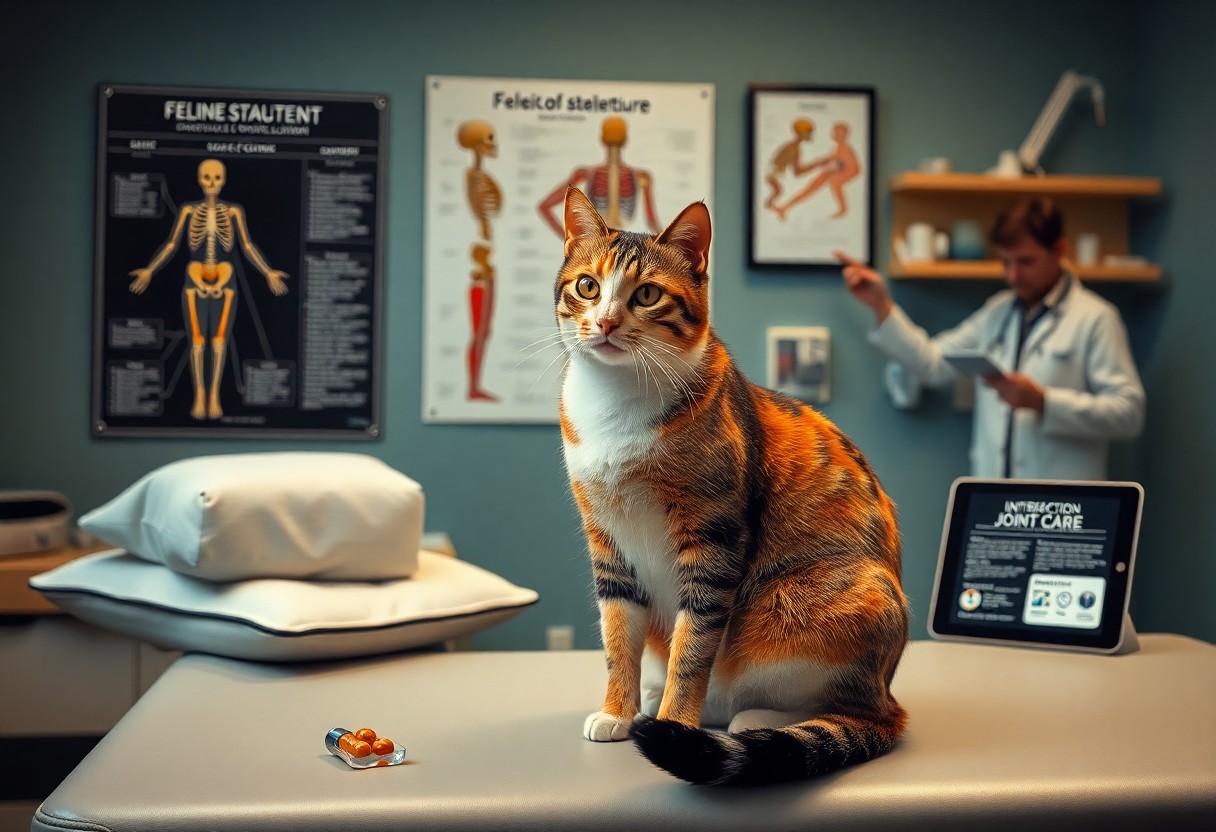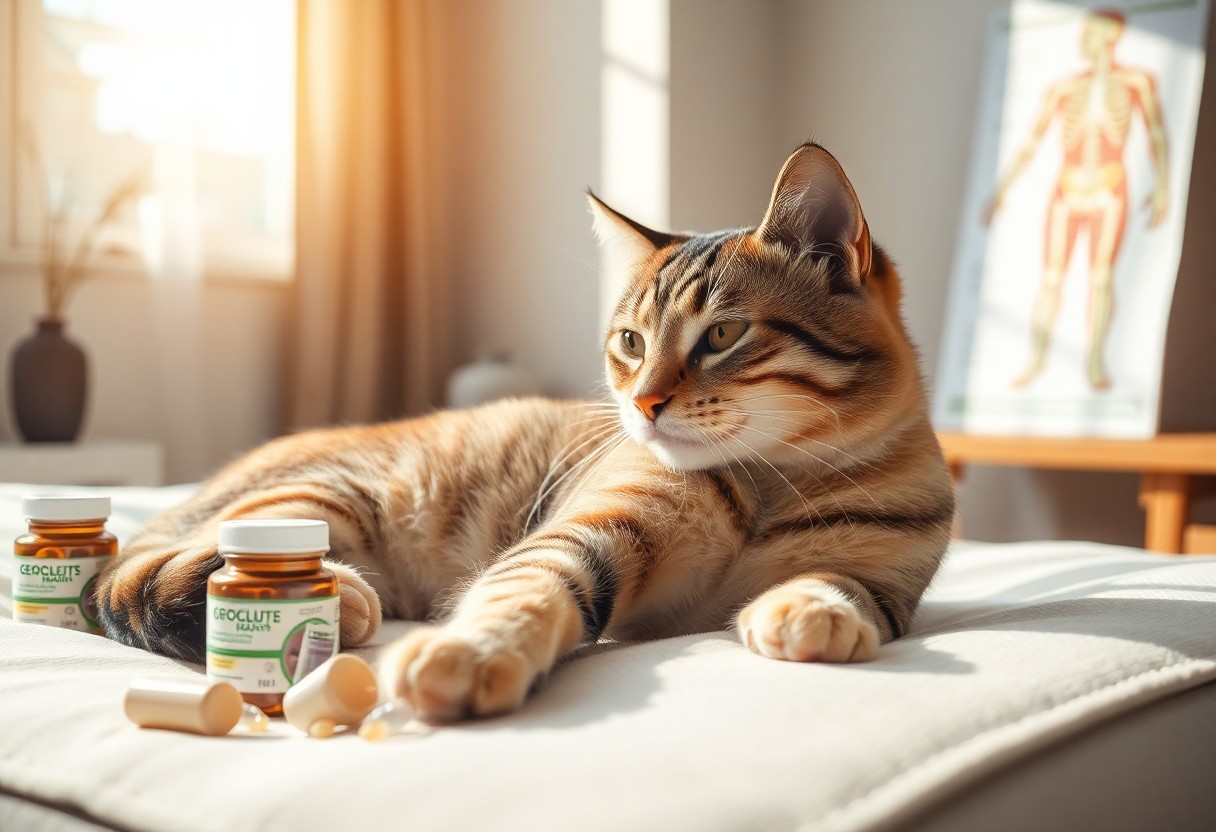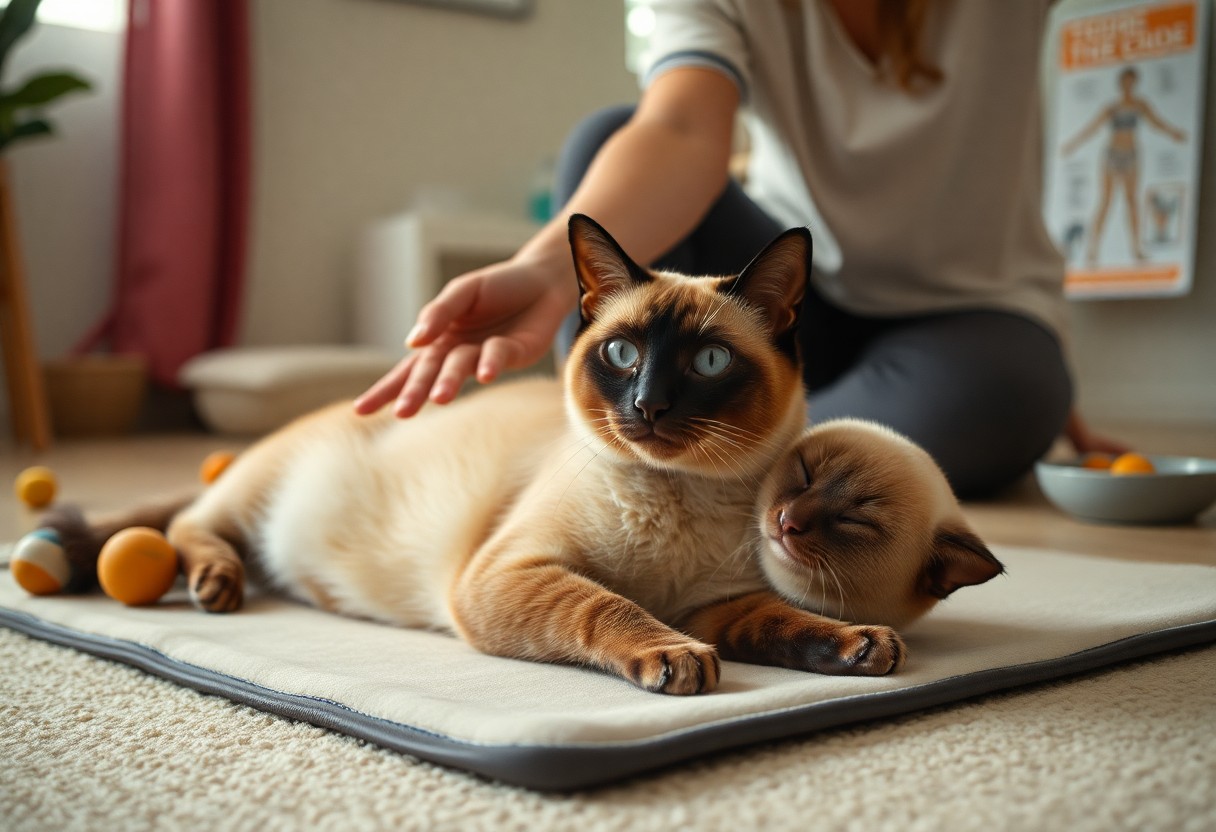Over time, cats can develop various joint and bone problems, particularly in certain breeds more susceptible to these issues. To provide the best care for your feline friend, you must understand their unique needs, nutritional requirements, and the signs of discomfort. This guide will equip you with the necessary strategies to help manage your cat’s health, promote mobility, and enhance their overall well-being. By taking proactive steps, you can significantly improve the quality of life for your cat and ensure they remain active and happy.

Understanding Joint and Bone Problems in Cats
Joint and bone problems can significantly impact your cat’s quality of life. Common issues include arthritis, hip dysplasia, and fractures, which often arise due to age, genetics, or injury. Understanding these conditions will help you recognize early signs and provide appropriate care, ensuring your cat remains comfortable and mobile.
Common Symptoms to Watch For
Observing your cat for signs of discomfort is vital. Common symptoms include limping, stiffness, difficulty jumping, and changes in activity levels. Keep an eye out for behavioral changes, such as increased irritability or reluctance to be handled, as these may indicate joint or bone pain.
Factors Contributing to Joint and Bone Issues
Several factors can lead to joint and bone problems in cats, including age, genetics, obesity, and past injuries. Certain breeds are predisposed to conditions like hip dysplasia or osteochondritis. Ensuring a healthy diet and maintaining a suitable weight are vital steps to mitigating these risks. Thou should regularly consult your veterinarian for tailored advice.
Age is a primary contributor to joint and bone issues, as the wear and tear on cartilage increases with time. Additionally, certain genetic predispositions can make specific breeds more susceptible to ailments. Obesity further complicates the situation, placing excess stress on joints and accelerating degeneration. Past injuries, even if they seem minor, can develop into chronic pain if untreated. Thou must focus on proactive care to minimize these risks.
- Age
- Genetics
- Obesity
- Past injuries
- Diet

How to Assess Your Cat’s Joint Health
Assessing your cat’s joint health involves observing changes in behavior, mobility, and overall well-being. Look for signs such as difficulty jumping, stiffness after resting, or decreased activity levels. Regularly monitor your cat’s weight, as excess pounds can put additional strain on their joints. Using a pain scale, consider their response to physical activity; the lower the response, the more likely there could be an issue. Ideally, you should establish a baseline of what is normal for your cat to spot deviations early.
Routine Evaluations
Routine evaluations are imperative for identifying potential joint issues before they escalate. Schedule annual veterinary check-ups where the vet can perform a thorough physical examination. They may assess your cat’s range of motion, listen for any unusual sounds in the joints, and monitor their gait. You can assist by keeping a detailed record of any behavioral changes or signs of discomfort to share with your vet, making it easier to address potential problems promptly.
When to Consult a Veterinarian
Consult a veterinarian if you notice persistent limping, difficulty rising, or reluctance to engage in normal activities. Increased vocalization or changes in grooming habits can also indicate pain or discomfort. Any sudden weight loss or gain, alongside these symptoms, warrants immediate professional evaluation. Catching issues early can greatly improve outcomes and provide your cat with a better quality of life.
When consulting a veterinarian, provide a comprehensive history of your cat’s health and behavior, including any dietary changes or recent stressors. Treatment options may range from pain management strategies to dietary modifications or physical therapy, tailored specifically to your cat’s condition. By being proactive and vigilant, you can help your veterinarian develop an effective plan to manage your cat’s joint health, ensuring a happier, more active life.
Tips for Creating a Comfortable Living Environment
Ensuring your cat with joint or bone problems has a comfortable living space can significantly enhance their quality of life. Consider providing soft surfaces for resting, reducing high jumps by placing food and litter boxes at ground level, and maintaining a warm environment. Calm spaces can help your cat feel secure and relaxed. Creating a routine can also be beneficial for their mental well-being. Any adjustments you make can contribute to their overall comfort.
Appropriate Bedding Choices
Choose bedding that offers ample support, such as memory foam or orthopedic mattresses, to alleviate pressure on your cat’s joints. Positioning beds in warm, quiet areas can further aid their relaxation. Ensure the bedding is easy to clean, as this will keep the space hygienic and inviting. Cats enjoy cozy spots that allow them to curl up and feel secure.
Modifying Living Spaces for Accessibility
Creating an accessible environment involves eliminating barriers that may hinder your cat’s movement. Incorporate ramps or steps for elevated surfaces, ensuring they can reach their favorite spots without strain. Maintain a clutter-free space to reduce obstacles as your cat navigates. Using non-slip mats can prevent accidents on slippery floors, enhancing their safety.
For optimal accessibility, assess your home layout. Consider adding furniture rearrangements that facilitate easier navigation. For example, a series of low platforms or strategically placed perches can create a gentle climbing route for your cat. Adjusting the positioning of food and water dishes can avoid unnecessary movement and potential discomfort. Utilizing ramps or pet stairs can greatly assist in reaching higher places without excessive jumping. Any modifications contribute to a more supportive and enjoyable living environment for your cat, allowing them to thrive despite their condition.
Nutrition Considerations for Cats with Joint Issues
Addressing nutrition is key in managing your cat’s joint health. Focus on providing a balanced diet enriched with omega-3 fatty acids, antioxidants, and imperative nutrients that promote joint function. Ingredients like fish oil and high-quality protein sources help reduce inflammation and maintain muscle mass, vital for supporting weakened joints. Your choice of food can significantly impact pain levels and overall mobility, so consider specialty diets designed for joint support as a proactive measure.
Diets That Support Joint Health
Consider diets rich in glucosamine, chondroitin, and omega-3 fatty acids to support joint health. Brands offering formulations specifically aimed at joint issues often include ingredients like chicken or fish as primary protein sources, along with added vitamins and minerals. These diets can help reduce inflammation and improve overall joint function, aiding your cat’s movement and comfort.
Supplements That May Help
Incorporating supplements can enhance your cat’s joint care regimen. Look for products with glucosamine and chondroitin, which support cartilage repair, along with omega-3 fatty acids for anti-inflammatory benefits. Other effective options include MSM for pain relief and curcumin for its antioxidant properties. Administering these supplements consistently can yield positive results, helping to improve mobility and reduce discomfort.
For maximum benefit, consider a combination of supplements tailored to your cat’s specific needs. Glucosamine serves to rebuild cartilage, while chondroitin aids in nutrient absorption. Omega-3 fatty acids, often sourced from fish oil, help manage inflammation. Many veterinarians recommend administering these supplements alongside your cat’s food, ensuring proper absorption. Regular consultation with your vet will help in determining the right dosages and combinations, ensuring your cat receives optimal care for their joint issues.

How to Encourage Gentle Exercise
Incorporating gentle exercise into your cat’s routine fosters mobility and enhances joint health. Begin with short play sessions, gradually increasing duration as your cat becomes more comfortable. Aim for a consistent schedule that suits your cat’s energy levels, ensuring they enjoy the activity without overexertion.
Playtime Activities
Engaging your cat in light playtime activities helps maintain their interest and fitness without straining their joints. Use feather wands, laser pointers, or soft balls to entice them into slow, gentle movements. Opt for interactive toys that stimulate their minds while allowing them to play at their own pace.
Safe Mobility Assistance Tools
Mobility assistance tools can significantly help your cat navigate their environment more safely. Consider using items like pet ramps, supportive harnesses, or padded beds that ease movement and reduce strain on joints. These tools allow your cat to maintain independence while ensuring their safety.
Pet ramps can assist your cat in accessing higher surfaces without jumping, which could exacerbate joint pain. Look for ramps with a non-slip surface and a gentle incline to make it easier for your cat to utilize them. Supportive harnesses can help during walks, providing added stability. Soft, orthopedic beds can also be pivotal—providing cushioning and support for aching joints. Investing in these tools promotes mobility and enhances your cat’s quality of life, allowing them to move comfortably and safely at home.
Monitoring and Track Progress
Regularly monitoring your cat’s condition plays a vital role in managing their joint or bone problems effectively. Establish a routine for observing changes in their mobility, behavior, and overall health. Frequent check-ins can help you identify patterns, measure progress, and adjust care strategies as needed to enhance your cat’s well-being.
Keeping a Health Journal
Maintaining a health journal allows you to document your cat’s daily activities, medication schedules, and any noticeable changes in their condition. Include specific details such as their pain levels, appetite, and mobility issues. This resource will be invaluable for assessing treatment effectiveness and providing your veterinarian with accurate information during check-ups.
Recognizing Improvement or Deterioration
Observing subtle changes in your cat’s behavior can indicate whether their condition is improving or worsening. Improved mobility, increased activity, and playful behavior suggest that the treatment is effective, while reluctance to move, decreased appetite, or visible signs of pain may signal a need for intervention.
For instance, if your cat starts using stairs they previously avoided, or displays eagerness during playtime, these are signs of improvement. In contrast, if you notice that they are avoiding jumping or seem withdrawn, it’s imperative to reevaluate their treatment plan. Keep track of these signs to initiate timely conversations with your veterinarian, ensuring that your cat receives the best possible care tailored to their specific needs.
Summing up
As a reminder, caring for cats with joint or bone problems requires attention to their specific needs to enhance their comfort and quality of life. You should provide a balanced diet, ensure they have a comfortable living space, and consider joint supplements as advised by your veterinarian. Regular, gentle exercise is important to maintain mobility without overexertion. Additionally, keeping their weight in check will reduce stress on their joints. By following these guidelines, you will help your cat lead a healthier, happier life despite their joint or bone issues.
FAQ
Q: What are common joint or bone problems in cats?
A: Common issues include arthritis, hip dysplasia, and osteoarthritis. Symptoms may involve limping, reluctance to jump, or changes in behavior.
Q: How can I tell if my cat is in pain due to joint problems?
A: Signs of pain in cats may include changes in grooming habits, decreased activity, hiding, vocalizations, or unusual aggression. Observing these behaviors can indicate discomfort.
Q: What dietary changes can support joint health in cats?
A: Incorporating high-quality proteins, omega-3 fatty acids, and joint supplements like glucosamine or chondroitin can benefit joint health. Always consult a veterinarian before changing your cat’s diet.
Q: Are there specific exercises that are beneficial for cats with joint issues?
A: Gentle stretching, short walks, and interactive play sessions can promote mobility without overstressing the joints. Tailoring activities to your cat’s comfort level is important.
Q: When should I consult a veterinarian regarding my cat’s joint health?
A: Consult a veterinarian if you notice persistent pain, difficulty moving, or if your cat’s behavior changes significantly. Early intervention can improve management of joint problems.

